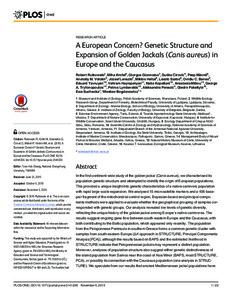Будь ласка, використовуйте цей ідентифікатор, щоб цитувати або посилатися на цей матеріал:
http://elar.tsatu.edu.ua/handle/123456789/4200| Назва: | A European Concern? Genetic Structure and Expansion of Golden Jackals (Canis aureus) in Europe and the Caucasus |
| Автори: | Rutkowski, R. Männil, P. Ćirović, D. Yavruyan, E. Hayrapetyan, V. Volokh, Anatolii Волох, Анатолій Михайлович Волох, Анатолий Михайлович Lanszki, J. Heltai, M. Szabó, L. Krofel, M. Banea, O. Suchecka, E. Bogdanowicz, W. |
| Дата публікації: | 2015 |
| Серія/номер: | PLOS ONE;Vol. 5 |
| Короткий огляд (реферат): | In the first continent-wide study of the golden jackal (Canis aureus), we characterised its population genetic structure and attempted to identify the origin of European populations. This provided a unique insight into genetic characteristics of a native carnivore population with rapid large-scale expansion. We analysed 15 microsatellite markers and a 406 basepair fragment of the mitochondrial control region. Bayesian-based and principal components methods were applied to evaluate whether the geographical grouping of samples corresponded with genetic groups. Our analysis revealed low levels of genetic diversity, reflecting the unique history of the golden jackal among Europe’s native carnivores. The results suggest ongoing gene flow between south-eastern Europe and the Caucasus, with both contributing to the Baltic population, which appeared only recently. The population from the Peloponnese Peninsula in southern Greece forms a common genetic cluster with samples from south-eastern Europe (ΔK approach in STRUCTURE, Principal Components Analysis [PCA]), although the results based on BAPS and the estimated likelihood in STRUCTURE indicate that Peloponnesian jackals may represent a distinct population. Moreover, analyses of population structure also suggest either genetic distinctiveness of the island population from Samos near the coast of Asia Minor (BAPS, most STRUCTURE, PCA), or possibly its connection with the Caucasus population (one analysis in STRUCTURE). We speculate from our results that ancient Mediterranean jackal populations have persisted to the present day, and have merged with jackals colonising from Asia. These data also suggest that new populations of the golden jackal may be founded by long-distance dispersal, and thus should not be treated as an invasive alien species, i.e. an organism that is “non-native to an ecosystem, and which may cause economic or environmental harm or adversely affect human health”. These insights into the genetic structure and ancestry of Baltic jackals have important implications for management and conservation of jackals in Europe. The golden jackal is listed as an Annex V species in the EU Habitats Directive and as such, considering also the results presented here, should be legally protected in all EU member states. |
| URI (Уніфікований ідентифікатор ресурсу): | http://elar.tsatu.edu.ua/handle/123456789/4200 |
| DOI: | 10.1371/journal.pone.0141236 |
| Розташовується у зібраннях: | кафедра Геоекологія та землеустрій |
Файли цього матеріалу:
| Файл | Опис | Розмір | Формат | |
|---|---|---|---|---|
| 2015 A European Concern.pdf | 2.74 MB | Adobe PDF |  Переглянути/Відкрити |
Показати повний опис матеріалу
CORE Recommender
Перевірити
Усі матеріали в архіві електронних ресурсів захищені авторським правом, всі права збережені.
